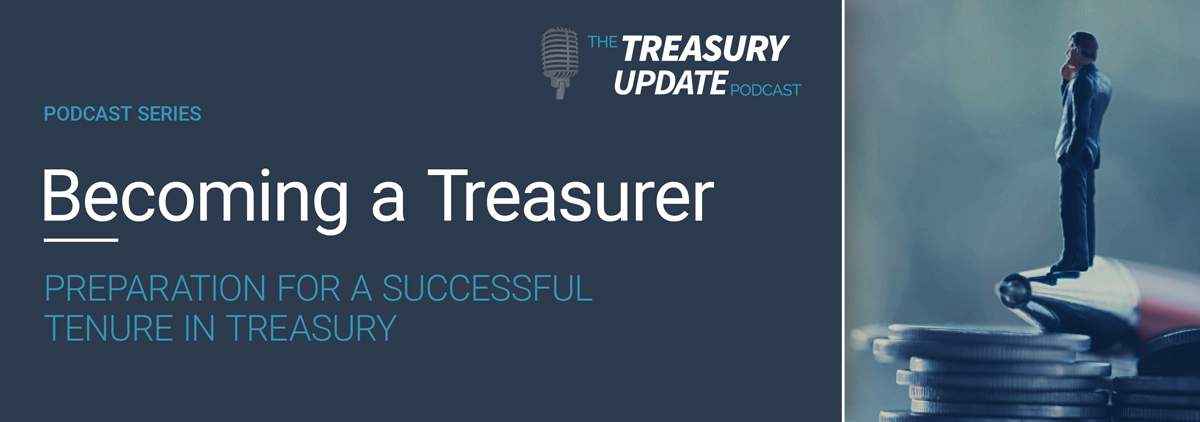
Episode 111
Becoming a Treasurer:
Part 12 – Learning from Literature:
Thinking & Analysis. A.A. Milne
What can Winnie-the-Pooh teach us about treasury? On this episode of the Becoming a Treasurer series, Host Craig Jeffery continues the Learning from Literature sub-series showcasing English author A. A. Milne’s Winnie-the-Pooh character. This thinking and analysis session covers concrete examples of persevering, focusing and being thoughtful while overcoming the bumps on your journey. Listen in to this engaging conversation to find out some tools for success on becoming a treasurer.
Host:
Meredith Zonsius, Strategic Treasurer


Speaker:
Craig Jeffery, Strategic Treasurer


Episode Transcription - Episode 111 - Becoming a Treasurer Part 12
Meredith Zonsius:
What can Winnie-the-Pooh teach us about treasury? On this episode of the Becoming a Treasurer series, host Craig Jeffery continues the Learning From Literature sub-series, showcasing English authors, A. A. Milne’s Winnie the Pooh character. This thinking and analysis session covers concrete examples of persevering, focusing, and being thoughtful. Listen in to this engaging conversation to find out some tools for success on your journey to becoming a treasurer. Welcome to the podcast, Craig.
Craig Jeffery:
Thanks, Meredith. It’s good to talk again on treasury topics.
Meredith Zonsius:
So you’ve expressed concern about doing several Becoming a Treasurer episodes so close together. But please know this is a very popular series, so I really appreciate you coming back on the show and I’m doing another episode. In our 12th episode, we revisit the learning from literature concept. So what do you have for us this time?
Craig Jeffery:
Well, episode 11, of the Becoming a Treasurer series was about risk and we used that Robert Frost poem as a launching point, that’s in Going From Room to Room in the Dark. And this episode or 12, is the beginning of A. A. Milne’s famous book called Winnie-the-Pooh. I like to refer to it as a business and relationship book. It’s also a children’s book, of course, as you know. But it’s part of the beginning of the book where it introduces us to Pooh and to Christopher Robin.
Meredith Zonsius:
A very popular book. I love the Winnie-the-Pooh book. Do you have this one memorized?
Craig Jeffery:
Pretty much. I’ve said it a lot. I get most of it right from memory. Sometimes they mess up on the last paragraph, but I’ll read it now. I call it bump, bump, bump. It’s really part of the first chapter. It says, “Here is Edward Bear, coming downstairs now, bump, bump, bump, on the back of his head, behind Christopher Robin. It is, as far as he knows, the only way of coming downstairs, but sometimes he feels that there really is another way, if only he could stop bumping for a moment and think of it. And then he feels that perhaps there isn’t.” So that’s the section in the front of the Winnie-the-Pooh, the book.
Meredith Zonsius:
Excellent. This is the second piece of literature that has bumping the head as the key action part. Is this a favorite theme?
Craig Jeffery:
I guess so. I guess it’s very visual to me. The other one was clonking your head on the door that that makes its way in between your fingers. And then this one is a stuffed bear having his noggin bumped every single time his owner or Christopher Robin takes a step down the stairs.
Meredith Zonsius:
Tell me what can those who are on their way to becoming a treasurer learn from this?
Craig Jeffery:
Well, a CFO, one time we were talking about projects and activities and he quoted this some years back and it really stuck with me. And this is a great children’s book. And Milne is really, really good at using words to make us picture everything in our mind, very vividly. And you can picture the stuffed bear being dragged by a leg and having his stuffed head bumping off of each step, not getting hurt, but you can just picture it. You can picture the bumping as it happens. That isn’t all that there is. He doesn’t just describe the scene, he gets into it in more detail. So it’s not wooden in any way. It’s there’s bumping on his head. There’s this idea of a distraction from being able to think about a better way of doing things like coming down the stairs, for example.
Craig Jeffery:
He recognizes to some extent, given that you have stuffing in your head as a bear, that there’s got to be a better way. And the distraction gives him that feeling of maybe there isn’t a better way. There’s too much of a distraction. And the real point here is why we might use that for treasurers is that we want to be more effective. We need to learn to think and do analysis properly, but there’s a lot of distractions that come up, a lot of bumping. And that’s why I think this is … We can learn from a children’s story to be better treasurers. And if you’re on your way to becoming a treasurer, we have to think about how to come down the stairs better.
Meredith Zonsius:
I’ll be interested in hearing how you link this to treasury. What can Winnie-the-Pooh teach us about treasury?
Craig Jeffery:
Well, not just storing up as honey. But, I think about this story and this example of coming down the stairs, sort of like a coat rack, that there’s some hooks, different hooks that we can use. I mean, one is this idea of leading or following. Now, it doesn’t say that, but he’s following behind Christopher Robin, being dragged by his leg. And as a stuffed animal, he really can’t propel himself so he doesn’t have much choice. But as professionals, wherever you are in your career, you want to make sure if you’re not leading, you’re following, you’re upright, you’re being more thoughtful in that approach.
Craig Jeffery:
And that’s tied into the second point about, are you going to be reactive, proactive, or thoughtful? It’s easy to say, I want to be proactive, not reactive, but there’s an aspect of being thoughtful, which is essential to being proactive. So reactive means you’re playing catch up and you’re oftentimes bumping your head. You don’t have your feet under you in the right order, intellectually. And proactive may seem to be, that’s the antidote we want. But I think the idea is we need to make sure we’re being thoughtful. And this is more than just planning, but it does include planning. It might be redesigning, re-imagining, prioritizing, doing those types of things. What has to be done, what is the most important, how can I free up more time to think, and what can be stopped? And so those are the first two. Well, I’ll cover a couple more as well.
Craig Jeffery:
And you’ve heard me say it before, Tyranny the Urgent, and I always remember reading a book about that. The urgent compresses our time and focuses our thinking on a single task. It’s a bit of an emergency, so you focus on things. And it’s easy to fill up our day and our life with that, our professional life, our personal life. But there are many times we won’t have the ability to step back and figure out what we need to do, but we have to make sure we create space and time to be able to think about important things carefully and repeatedly and do that type of analysis and synthesis of what we’re learning.
Craig Jeffery:
And then finally, there’s, I’m stretching this one a bit, but it’s perseverance versus giving up. I don’t control my time. My boss has all of these priorities that I have to do. Most of my job is fighting fires. That idea there has to be a better way if only I could stop to think about it. So this idea of we can’t give up and sometimes it’s hard to find the time to figure out what’s better and make making sure that you’re figuring out better ways of doing things or finding better ways of not doing something brings us to those four hooks that we can use, leading or following, reactive, proactive, or thoughtful, tyranny of the urgent, and perseverance versus giving up.
Meredith Zonsius:
Those are great points, especially nowadays where there’s so many distractions and people trying to work from home, and get their job done, and please their boss, and prioritize. So those are great. Maybe you can move into some more concrete examples of persevering, focusing, and being thoughtful.
Craig Jeffery:
Sure. I think there’s a lot more people who are far better at this discipline than I am. My typical solution is I throw more time at an issue until I can make the room. That’s part of my default. But I’ll give you an example. We use Office 365, and they started this reporting and it gives you a recap of your week. How much time did you spend collaborating with people? How much time was undisturbed, thinking time, creative time? So they give a report that helps say, how am I keeping my work and thought life, my work task life and my work thought life balanced? What’s focused, what’s collaborative? This idea of are we thinking about thinking, or do we think about the value of thinking? How do I know what to focus on?
Craig Jeffery:
This idea of value, what’s the value in thinking, have you thought about that? This idea of if you focus time to think, to plan, to analyze, strategize, synthesize those things that you know, and apply them to your situation, what‘s the value to your life, your week, your company, and to your career. And I think when we think about that, we say that is something we need to be more deliberate about. There’s a lot of distractions and we can just complain about being at two meetings. Will you lean towards, how can I get out of these meetings, or I’ll just multitask during the meetings, or I missed that, can you repeat the question type response where we’re just distracted and not truly isolating thinking time from collaborating time and being able to say no.
Craig Jeffery:
And the other distraction I think is this concept of sometimes we don’t think of planning and thinking as work, or we view it as that’s not real work. Are you daydreaming? No, I’m thinking through the issues. This is good work and it doesn’t seem like you’re thinking, you’re leaning back in your chair. But that is real work and it can be really valuable work. The other thing, I laugh a little bit about that concrete examples is the perspective on protecting Pooh’s brain, right? He can’t think because his heads bumping, there’s too many distractions.
Craig Jeffery:
And, just thinking about what’s the best piece of capital you have? Is that your car? Is it a machine? Is the computer on your desk, your phone? Your brain is the best piece of capital you have, even though you didn’t necessarily have to pay for it, but you certainly have paid time and money, whether it’s education or learning. And it is a lever, it’s a giant lever that you can and should use. How can you extend the length of that lever? Why aren’t you using your brain more? Those are questions. Protect it and use it, whether it’s Pooh’s brain or your own.
Meredith Zonsius:
How do you take time or make the time? I know that that at times can be a juggling act.
Craig Jeffery:
Well, yeah, making time is a sense of priorities, for sure. Sometimes you can trade money for time. So that may mean you pay for something to be done that absorbs time that would distract you from thinking. But one thing, I probably got about four things for this, but one would be booking time on your calendar to focus and analyze or your time’s going to get filled up. I remember this one project manager, every time she had a meeting scheduled, she would book an hour on her calendar for documenting and following up. And I thought, well, that’s brilliant because otherwise you pack everything into your day and then you’re doing your documentation, or your communication, or your thinking two days distant, and now you’re trying to recreate something that was in the past. So, that was a good example.
Craig Jeffery:
But the idea about booking time in the calendar is knowing when is your best thinking time or writing time. Is it the morning, at lunch, in the afternoon, in the evening, maybe it’s Saturday morning? We may not do it because it doesn’t seem like work, but it’s certainly important to reserve time on your calendar, not just do it when it seems to hit the time you need. So, you might be busy, you have an idea that you want to develop more, but capture your idea, the idea that you have in the moment enough that you’ll remember it. And then expand upon that when you have some time. That would be the first to your question about how do you take or make the time.
Craig Jeffery:
The second one, I would venture to say is where to think. And do you think in your head or on some sort of medium, and what’s best for you, is it paper, on the desk? Is it whiteboard? Is it on your computer or is it in your mind? You probably know and understand what issues require you to solve only in your head or on the whiteboard. For me, most work-related concepts can be visualized in a way to show relationships, opportunities, and so I’ll sketch. I’ll use legal or the giant 11 by 17 sheets for larger concepts. On my own, it’s usually paper’s my best friend, then maybe the whiteboard. But in groups, if we’re thinking on the whiteboard, it allows us a shared way of working through concepts or ideas, and you can adapt and change those.
Craig Jeffery:
And certainly, there’s time for me, solely in your mind, not writing things down but when we think about things that have changed over time, it could be your business, for example, or your business mix, threats, strengths, weaknesses, et cetera. We may need to figure out those connections mentally, think about them, build the hypothesis that we want to test or some sort of narrative, how things are changing, what this means. How does computing power growth impact treasury? How must it? What do we need to do about that? What does this mean for our staff, for our technology stack that we use, what we spend money on, how does that influence our actions? So those are some of the elements about where to think, how to think, in your mind, on paper, with others, on a board, perhaps.
Meredith Zonsius:
Very good. It seems like you have more on what to do with the time you need to stop and think about it.
Craig Jeffery:
Yeah, there’s two others. One is a bit of a repeat from number two. Number three, though, I would say is, listen and learn from others. In your fields and other fields, their ideas can be directly useful or they might spark other ideas as you can combine a concept in some other industry, vertical or other discipline that gives you something for your work or your idea, just like A. A. Milne’s book. That is an idea that can be applied somewhere else. So, how are you getting that information into your head? Are you reading? Are you doing podcasts, listening to podcasts, reading different literature, and then even having conversations? So that’s different ways to learn.
Craig Jeffery:
And then the fourth category is, are we doing it alone, together? Do we do it both? I mean, some people love solving issues alone and then presenting them to a group. They want them to be perfect. Others work best together. They need the ideas from other people to spark and generate thought. All I want to say on that part is that there’s, and I think I’ve said this in some different podcasts, but there’s definitely some examples where we think about what are the primary styles that we use for the solutioning process if you will, linear thinkers and global thinkers. The linear thinker wants to solve things methodically and in order, well, you need to start here. This is first, then this is next. And it’s done in order. It tends to be sequential. And that’s a linear orderly thinker and that works great in some environments. It’s not the best in all environments, but it certainly works great in some.
Craig Jeffery:
And that can be contrasted with the global thinkers who may want to avoid some of the details, get the big stones in place, and then the rest can be fit in. The details can be worked out. And they might say things like, “Let’s take a step back,” versus we got to start here. You can’t get to there without the other one fitting in is the linear thinker. The globalist, let’s take a step back.
Craig Jeffery:
So how that works sometimes is, if the global thinker needs to help get things into an order, they may take a conceptual approach saying we’re trying to come up with concepts, not committing to any of the steps, but just working at them to see if we’re close and to see what we need to consider. And then you can move quickly from very different ideas. And then once that seems to be working out, then you have to go down into, oftentimes, a linear and methodical approach to seeing how that would be put into practice. And this is a good way of not bumping our heads together, but thinking of a better way to come down the stairs together so that everyone can contribute and engage.
Meredith Zonsius:
Yep. Everybody plays their part for sure. What are your final thoughts? Any final thoughts?
Craig Jeffery:
Sure. Just a few. I think the idea of what does Pooh Bear have to teach us, this idea of what we can learn from his experiences, know that we don’t always have to act in a reactive mode. We can be thoughtful. We don’t have to always live with the bump, bump, bump. There are times when things are going to go bump, bump, bump, the urgent has to be done, but that does not have to be the only way of coming down the stairs. And it might take time, it might take extra time. It might take deliberate action and planning to free that up. I remember … I can think of lots of examples where in my career, I’ve had to spend extra time to automate something or to do some planning, which would then free up substantial time or add substantial value where we’re not just responding to the urgent.
Craig Jeffery:
And this idea of to do this thoughtful approach, you really have to stop and think and you have to make the time, and it requires being intentional about it, which doesn’t mean I just intend to do it, but it means I intend to do it, I plan it, I make sure I do it, and then I follow through to deliver the results. So, I think we can say that even Winnie-the-Pooh can give us some good insights into what it takes to become a treasurer even though he was just talking about how he came down the stairs.
Meredith Zonsius:
Excellent. Craig, this has been a fun and informative conversation. I love the subseries on learning from literature. Looking ahead, I’m also excited about kicking off a new series next week entitled Stories From the Front: Leading Out of Crisis Into Recovery, featuring treasury and finance leaders from major corporations. They’ll be sharing fresh ideas, innovative new approaches, case studies to help guide and encourage the profession as we move into a state of recovery, so looking forward to that. Thanks again. And thanks to our listeners for tuning in today. Have a good one.
OUTRO:
You’ve reached the end of another episode of the Treasury Update podcast. Be sure to follow Strategic Treasurer on LinkedIn, just search for Strategic-Treasurer.
Related Resources
#TreasuryFAQ – YouTube Playlist
Check out our YouTube playlist covering many frequently asked questions in treasury!
Becoming a Treasurer – A Treasury Update Podcast Series
This series within The Treasury Update Podcast explores questions around being a successful treasurer. Topics discussed include preparation, what needs to be measured, effective communication, development of a team, and acquirement of resources needed.



